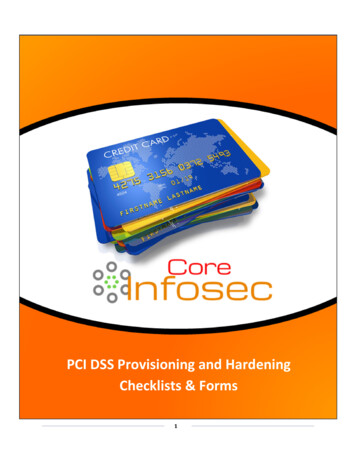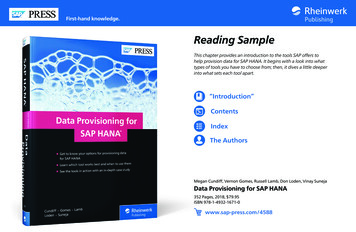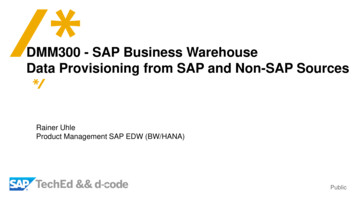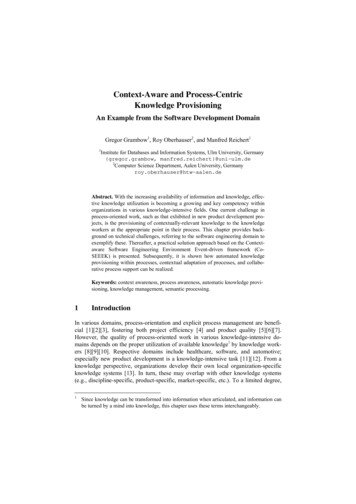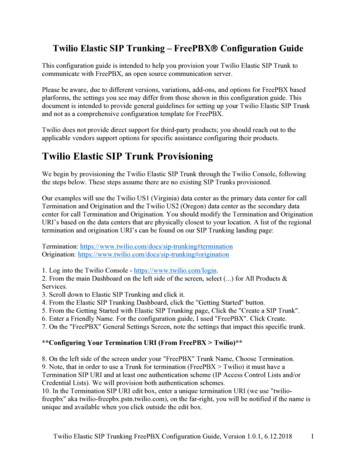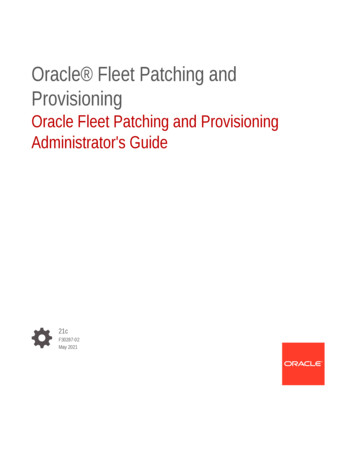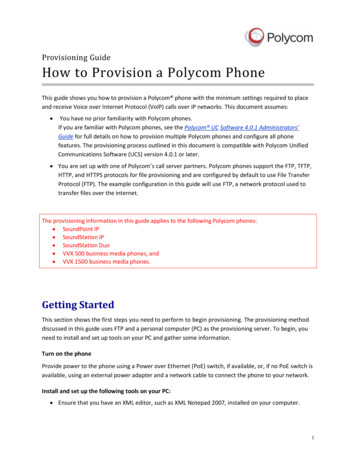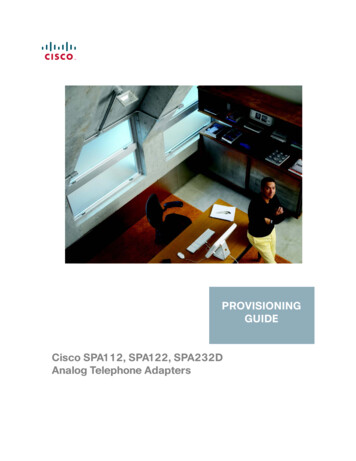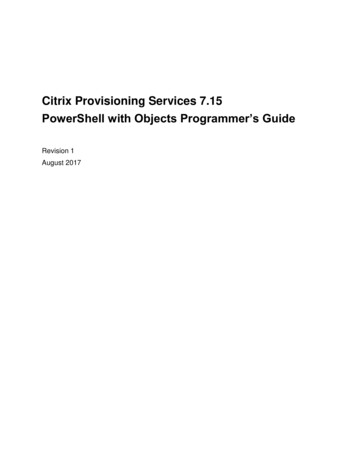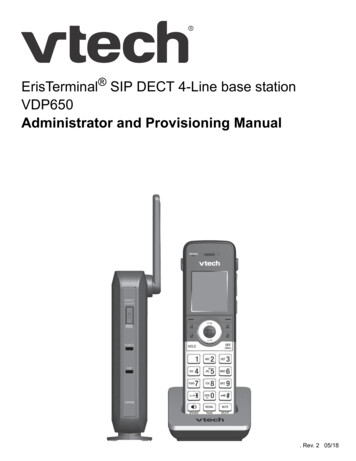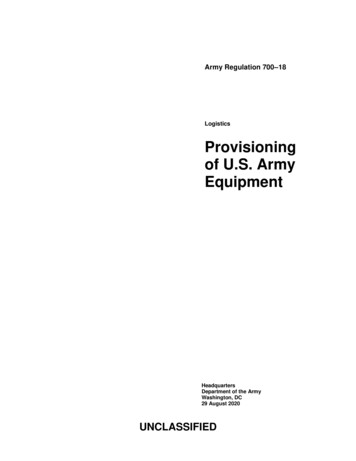
Transcription
Army Regulation 700–18LogisticsProvisioningof U.S. ArmyEquipmentHeadquartersDepartment of the ArmyWashington, DC29 August 2020UNCLASSIFIED
SUMMARY of CHANGEAR 700–18Provisioning of U.S. Army EquipmentThis major revision, dated 29 August 2020—oAdds concept of integrated product and process development throughout the acquisition process (para 1–4g(1)).oClarifies acquiring support and support-related engineering and logistics data for the provisioning process (para3–2).
HeadquartersDepartment of the ArmyWashington, DC29 August 2020*Army Regulation 700–18Effective 29 September 2020LogisticsProvisioning of U.S. Army EquipmentUnited States, and the U.S. Army Reserve, unless otherwise stated.History.vision.This publication is a major re-Summary. This regulation implements provisioning aspects of DoDI5000.02 and prescribes current Army provisioning policy and procedures.Applicability. This regulation appliesto the Regular Army, the Army NationalGuard/Army National Guard of theProponent and exception authority.The proponent of this regulation is theDeputy Chief of Staff, G–4. The proponent has the authority to approve exceptions or waivers to this regulation that areconsistent with controlling law and regulations. The proponent may delegate thisapproval authority, in writing, to a division chief within the proponent agency orits direct reporting unit or field operatingagency in the grade of colonel or the civilian equivalent. Activities may request awaiver to this regulation by providing justification that includes a full analysis ofthe expected benefits and must includeformal review by the activity’s senior legal officer. All waiver requests will be endorsed by the commander or senior leaderof the requesting activity and forwardedthrough their higher headquarters to thepolicy proponent. Refer to AR 25–30 forspecific guidance.Army internal control process.This regulation contains internal controlprovisions in accordance with AR 11–2and identifies key internal controls thatmust be evaluated (see appendix B).Supplementation. Supplementationof this regulation and establishment ofcommand and local forms are prohibitedwithout prior approval from the DeputyChief of Staff, G–4 (DALO– SUS), 500Army Pentagon, Washington, DC20310–0546.Suggested improvements. Usersare invited to send comments and suggested improvements on DA Form 2028(Recommended Changes to Publicationsand Blank Forms) directly to Headquarters, Department of the Army, Office ofthe Deputy Chief of Staff, G–4(DALO–SUS), 500 Army Pentagon,Washington, DC 20310–0500.Distribution. This regulation is available in electronic media only and is intended for the Regular Army, the ArmyNational Guard/Army National Guard ofthe United States, and the U.S. Army Reserve.Contents (Listed by paragraph and page number)Chapter 1Summary, page 1Purpose 1–1, page 1References and forms 1–2, page 1Explanation of abbreviations and terms 1–3, page 1Responsibilities 1–4, page 1Records management (recordkeeping) requirements 1–5, page 3Objective 1–6, page 3General requirements 1–7, page 3Requests for exceptions 1–8, page 4Chapter 2Planning and Managing Provisioning Programs, page 4Integrated logistics support 2–1, page 4Provisioning planning and scheduling 2–2, page 4Phased provisioning 2–3, page 4Provisioning review and evaluation 2–4, page 5*This regulation supersedes AR 700-18, dated 20 September 2009.AR 700–18 29 August 2020UNCLASSIFIEDi
Contents—ContinuedChapter 3Provisioning Technical Documentation, page 6Overview 3–1, page 6Data sources 3–2, page 6Documentation guidance 3–3, page 6Chapter 4Screening, Selecting, Coding, and Cataloging of Support Items, page 7Section IProvisioning Screening and Support Item Selection and Coding, page 7Overview 4–1, page 7Source, maintenance, and recoverability coding 4–2, page 7Demilitarization coding 4–3, page 7Essentiality coding 4–4, page 7Controlled inventory item code 4–5, page 8Item management coding 4–6, page 8Acquisition method code/acquisition method suffix code 4–7, page 8Section IIAssignment and Application of Maintenance Replacement Rates, page 8Summary 4–8, page 8Assignment 4–9, page 8Section IIIAssignment of Part Numbers and Reference Numbers, page 9Part numbers 4–10, page 9Reference numbers 4–11, page 9Section IVCataloging of Support Items, page 9Summary 4–12, page 9Supply support request 4–13, page 9Standardization of support items 4–14, page 10Chapter 5Requirements Computation and Initial Stockage Policy, page 10Description 5–1, page 10Requirements computations 5–2, page 10Provisioning data documentation 5–3, page 10Provisioning data review and update 5–4, page 10Demand development period 5–5, page 10Stratification 5–6, page 10Initial issue stockage at retail levels 5–7, page 11Development of program data for initial requirements computation 5–8, page 11Computational procedures for reprovisioning and follow-on provision 5–9, page 11National maintenance program 5–10, page 11Support and test equipment 5–11, page 11On-board spares 5–12, page 12Requisition wait time 5–13, page 12Long lead time items 5–14, page 12Training requirements 5–15, page 12Chapter 6Budgeting and Funding for Provisioning, page 12Overview 6–1, page 12Budgeting 6–2, page 12AR 700–18 29 August 2020ii
Contents—ContinuedProvisioning funding 6–3, page 13Special tools and test equipment 6–4, page 13Chapter 7Policy Governing Acquisition of Support Items, page 13Directive guidance 7–1, page 13Support item selection process 7–2, page 14Headquarters, Department of the Army approval 7–3, page 14End items new to the Army Supply System 7–4, page 14Meeting initial issue consumption via the supply system 7–5, page 14Acquisition of support items 7–6, page 14Chapter 8Support Items Lists, page 16Summary 8–1, page 16Repair parts and special tools list 8–2, page 16Items required for operation and operator and crew maintenance 8–3, page 16Components of end item 8–4, page 16Basic issue items 8–5, page 16Additional authorization lists 8–6, page 17Chapter 9Provisioning Procedures for Multi-Service Equipment and Systems, page 17Guidance 9–1, page 17The Army as the executive or lead Service 9–2, page 17Chapter 10Accelerated Provisioning, page 18System application 10–1, page 18Accelerated provisioning management goals and objectives 10–2, page 18Provisioning accountability 10–3, page 18AppendixesA. References, page 21B. Internal Control Evaluation, page 24GlossaryAR 700–18 29 August 2020iii
Chapter 1Summary1 –1. PurposeThis regulation prescribes the basic principles, objectives, policies, and responsibilities for provisioning Army systemsand end items (EIs). This regulation provides guidance for planning, managing, executing, and evaluating provisioningprograms within the framework of the acquisition process and integrated product support (IPS) techniques; acquiringand using provisioning technical documentation (PTD) and engineering data for provisioning (EDFP); provisioningactions associated with the provisioning decision process—that is, selecting, coding, computing, cataloging, procuring, and distributing of support items and spare and repair parts.1 –2. References and formsSee appendix A.1 –3. Explanation of abbreviations and termsSee the glossary.1 –4. Responsibilitiesa. Chief, National Guard Bureau. The CNGB will oversee the functions pertaining to the acquisition, supply,maintenance, and accountability of Federal property issued to the Army National Guard.b. Deputy Chief of Staff, G–4. The DCS, G–4 has Army General Staff responsibility for provisioning and will—(1) Establish a point of contact (POC) in the DCS, G–4 to implement Department of Defense (DoD) provisioningpolicy and coordinate all Army provisioning actions covered by this regulation.(2) Establish objectives, basic policies, and general procedures for provisioning, to include program objectivememorandum (POM) and budget procedures.(3) Assign responsibilities and monitor implementation of these policies and procedures by mission.(4) Approve—(a) Requests for authority to exceed limitations.(b) Waivers from compliance with policies and procedures in this regulation.c. Chief, Army Reserve. The CAR will—(1) Provide appropriate materiel provider with total quantities of U.S. Army Reserve (USAR) equipment appropriations procurements no later than 30 days after congressional notification.(2) Prepare and submit DD Form 448 (Military Interdepartmental Purchase Request (MIPR)) for funding of USARprovisioning for the appropriate materiel provider.d. The Surgeon General. TSG is responsible for overall management of an Armywide health services system, toinclude lifecycle management of medical materiel according to AR 40–60. Specific management responsibilities related to provisioning include planning, programming, and acquiring materiel in support of all TSG-managed items.e. Commander, U.S. Army Corps of Engineers. The Commander, USACE will—(1) Have overall management of USACE EIs.(2) Plan, program, and acquire materiel for overall support under the purview of this regulation.f. Commanders of Army commands, Army service component commands, direct reporting units, and their life cyclemanagement commands. The commanders of ACOMs, ASCCs, DRUs, and their LCMCs with a provisioning missionwill—(1) Establish controls to ensure the objectives of provisioning (see para 1–6) are accomplished.(2) Coordinate and ensure the timeliness and effectiveness of all IPS identified provisioning actions.(3) Develop and publish procedures to implement DoD and Department of Army (DA) provisioning policy.(4) Review actions and forward the following requests through appropriate channels with justification to the DCS,G–4 (DALO–SMR) for approval:(a) Authority to exceed limitations specified herein.(b) Waivers from compliance with policies and procedures in this regulation.(c) Deviations from this regulation.(5) Establish an audit trail for provisioning evaluation of shop stock list (SSL) and authorized stockage list (ASL)items for major systems and EIs identified by the U.S. Army Training and Doctrine Command (TRADOC).AR 700–18 29 August 20201
(6) Develop a PP in conjunction with the total life cycle system manager (TLCSM) that will be summarized in thesupportability strategy (SS) and the acquisition strategy. Coordinate the PP with involved logistics activities, includingother U.S. Army Materiel Command (AMC) LCMCs, other military Services, Defense Logistics Agency (DLA), andGSA. All participating activities will be provided with a coordinated copy of the PP. The PP will be updated as required, and changes will be provided to all affected activities.(7) Acquire provisioning data that promotes Government acquisition of technical data sufficient to establish anenvironment suitable for competitive acquisition of support items—that is, items that support the requirements for theDoD parts breakout program as specified in the Defense Federal Acquisition Regulation Supplement Procedures,Guidance, and Information, subpart 217.75 (DFARS PGI 217.75).(8) Obtain field feedback data necessary to update engineering estimates used in provisioning and validation of themaintenance concept.(9) Participate in the acceptance and approval of engineering change proposals (ECPs), materiel changes (MCs),and modification work orders (MWOs) to ensure the identification and development of changes to logistical data forprovisioning support.(10) Develop, implement, and use an institutionalized procedure to acquire provisioning related historic data toupdate the provisioning database on a continuing basis.g. Army materiel developers/total life cycle system managers. Army MATDEVs/TLCSMs will—(1) Apply the concept of integrated product and process development throughout the acquisition process. Utilize,to the maximum extent practical, support provided by the AMC to facilitate accurate and complete provisioning activities. Ensure all necessary support personnel from all disciplines are included within the integrated product team.(2) Coordinate provisioning requirements with all agencies and activities concerned with initial materiel supportto ensure thorough provisioning planning (PP) is accomplished in compliance with the IPS planning process.(3) Coordinate provisioning requirements with the DLA, General Services Administration (GSA), and other military departments or Government agencies (for example, the National Aeronautics and Space Administration and theFederal Aviation Administration), as required.(4) Convene and participate in provisioning meetings, conferences, and other provisioning activities.(5) Structure all provisioning actions to support the required weapon system availability or system readiness objective (SRO).(6) Ensure the maintenance concept is understood as a living construct to be periodically revalidated. Revalidationwill occur annually during the five years after initial fielding.(7) Ensure data required to develop the maintenance concept is sufficient to derive Government generated codesand will be displayed in an integrated data environment.(8) Plan, coordinate, and fund post provisioning reviews (PPRs) and post fielding analysis for all systems.(9) Ensure that newly fielded equipment can be sustained through the early phases of combat operation by planning, programming, budgeting, executing, and distributing Army prepositioned stocks (APS) items. Army guidancefor war reserve support is provided by the DCS, G–4 (DALO–ORC–CA).(10) Establish a memorandum of agreement (MOA) among all agencies involved in a specific program.(11) Provide EDFP to facilitate the preparation of full descriptive item identifications in support of Army-managednational stock numbers (NSNs) and DLA- and GSA-managed NSNs.(12) Ensure that combat developers (CBTDEVs), logisticians, trainers, testers, supporting commands, contractors,DLA, GSA, and, as appropriate,
and end items (EIs). This regulation provides guidance for planning, managing, executing, and evaluating provi sioning programs within the framework of the acquisition
